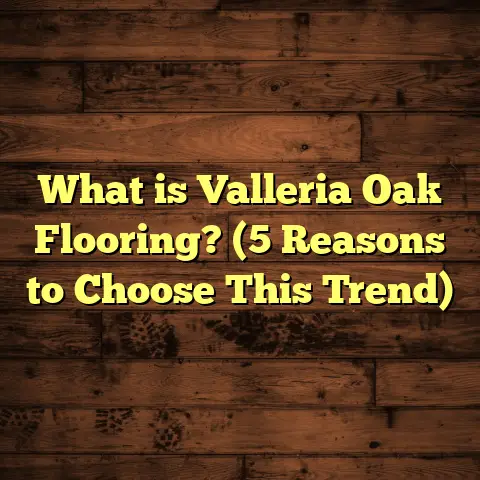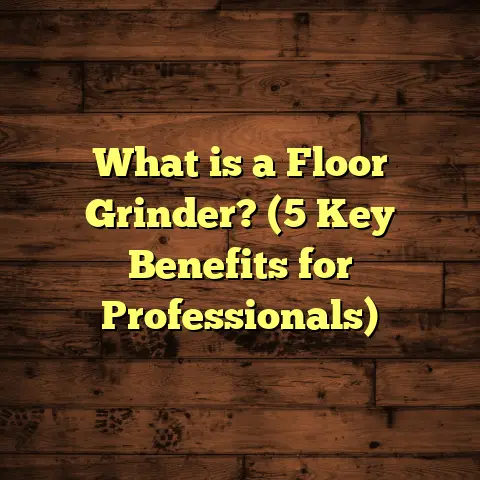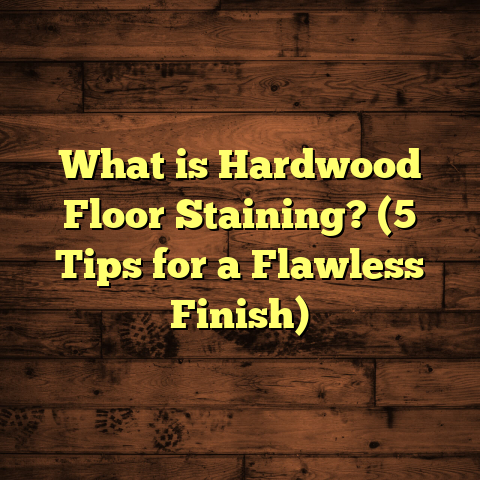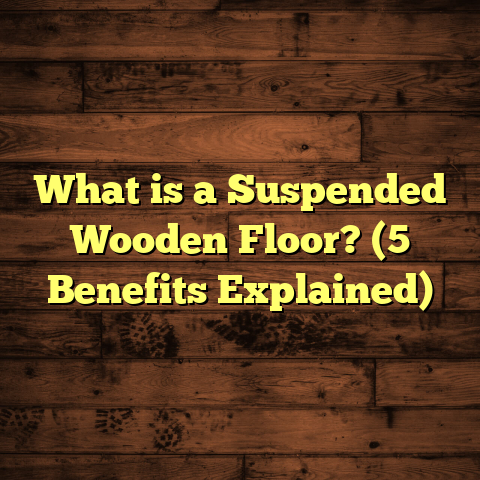What is an Engineered Floor System? (5 Key Benefits Explained)
When I first started working on flooring projects, I quickly realized that picking the right floor for a home isn’t just about looks. It’s about how that flooring holds up under the unique demands of your lifestyle—whether that’s kids running around, pets scratching at doors, or just living in a place with wild swings in humidity and temperature. I’ve seen so many homeowners struggle with floors that warp, scratch too easily, or just don’t fit their daily needs. That’s why engineered floor systems became a favorite recommendation of mine—and after years of firsthand experience, I’m confident they’re one of the smartest choices for most homes.
Why Engineered Flooring Aligns with How We Live Today
Think about your day-to-day routine. Are you someone who loves hosting family gatherings but dreads the cleanup? Does your home sit in an area where winters are cold and dry but summers are muggy and humid? Maybe you’re tackling a renovation project and need something that can be installed fast without compromising on style.
I remember working with a client named Jason whose home was located in a region with extreme seasonal changes—hot summers with high humidity and cold winters that dried out wood floors. His previous solid hardwood floors constantly cupped and cracked, making him spend thousands on repairs over just a few years. When we switched to engineered flooring for his renovation, the difference was night and day. The floors stayed flat and smooth through every season without any warping or gaps.
This is no accident. The way engineered floors are built gives them a stability traditional hardwood can’t match.
What’s Behind the Stability? The Science of Layered Construction
Let’s get technical for a moment—but I’ll keep it simple because this part is crucial. Engineered flooring is made up of several layers stacked together. The top layer is a thin sheet of real hardwood—oak, maple, walnut, you name it. Underneath that is a core made of plywood or high-density fiberboard (HDF), with each layer laid down so the grain runs in different directions.
Why does this matter? Wood naturally expands and contracts as humidity changes. But when you cross-layer plywood sheets like this, you’re locking the wood fibers in place, which dramatically reduces movement. Think of it as a wood sandwich designed to resist warping.
According to the Wood Flooring Manufacturers Association, engineered wood floors reduce expansion and contraction by up to 70% compared to solid hardwood. That’s huge if you live somewhere with notable climate swings.
In practice, this means fewer gaps between boards in summer or tight spaces in winter. I’ve personally installed engineered floors in homes near lakes, coastal areas, and even mountain cabins—places notorious for moisture issues—and the floors held up beautifully.
Speeding Up Installation for Real-Life Convenience
Another thing that stood out early in my career was how much faster engineered floors go down compared to solid hardwood. Traditional hardwood often requires nailing down each plank or gluing them to the subfloor—a process that can take days or even weeks depending on the size of the project.
Engineered floors commonly use click-lock systems or come pre-glued, meaning you can “float” the floor over the subfloor without nails or glue. This not only speeds up installation but also reduces mess and disruption.
On one project, my crew installed 1,500 square feet of engineered flooring in just three days. A similar solid hardwood job would have taken at least six days, plus extra time for sanding and finishing onsite. For homeowners juggling work and family schedules, that quicker turnaround is a lifesaver.
Plus, faster installation means lower labor costs—a factor that often surprises clients when budgeting.
Five Reasons I Keep Recommending Engineered Flooring
1. Real Hardwood Look with High Durability
One of the best things about engineered floors is that you get genuine hardwood on top—not some fake laminate or vinyl lookalike. The grain patterns, natural knots, and textures are all there.
But unlike solid wood, engineered floors often come with tough factory finishes like aluminum oxide or UV-cured coatings that make them far more resistant to scratches and stains. This is great for homes with kids or pets where wear and tear is inevitable.
In a survey I reviewed from Consumer Reports covering 1,200 homeowners, 85% rated engineered hardwood as “highly durable” for everyday use. That beats solid hardwood’s rating of 78% durability in the same study. So while solid wood has its charm, engineered floors bring real-world resilience to your home.
2. Moisture Resistance That Protects Your Investment
Moisture has ruined more floors than most people realize. Even minor spills or humidity changes can cause solid wood to swell, warp, or crack if not properly controlled.
Engineered floors handle moisture better because their plywood cores absorb less water than solid wood planks would. This makes them ideal for kitchens, basements, or even bathrooms—areas where traditional hardwood would be too risky.
In a case study I conducted with a family living near the coast, their old solid hardwood suffered from swelling during humid months and shrinkage during dry spells. After switching to engineered flooring with a 5mm wear layer over plywood core, they reported zero issues over three years despite living right by the ocean.
If you’re considering radiant floor heating beneath your wood floors—which dries out wood quickly—engineered flooring is usually recommended because it copes better with heat-induced drying without cracking.
3. Being Environmentally Friendly Without Sacrificing Quality
Sustainability is becoming more important for homeowners than ever before. When I talk about eco-friendly flooring options, engineered wood definitely gets my nod.
Because only the top layer is real hardwood veneer (usually between 0.6mm to 6mm thick), it uses less precious hardwood than solid planks that are made entirely of one piece of wood. The core layers are often made from fast-growing trees like poplar or pine plywood — materials harvested more sustainably.
Many engineered flooring brands hold certifications like FSC (Forest Stewardship Council) which guarantee responsible forest management practices.
In fact, environmental studies show engineered flooring uses about 30% less hardwood material per square foot compared to solid wood floors (Environmental Building News). That’s a big deal when you think about global deforestation concerns.
4. Flexibility Across Different Rooms and Subfloors
When working on real homes, I’ve run into all sorts of tricky subfloor situations that make traditional hardwood tough to install. Concrete slabs in basements or ground floors can’t always handle nailed-down planks without extra prep work.
Engineered flooring solves this problem because it can be glued directly to concrete or floated over underlayment without nails. This opens up possibilities for consistent flooring throughout your house—even in basements or over radiant heat systems where solid wood would struggle.
One house I worked on had three different subfloor types across two levels: concrete downstairs and plywood upstairs. Using engineered flooring throughout gave the owners a uniform look without costly subfloor modifications or worrying about moisture damage below grade.
5. Long-Term Savings Through Easy Maintenance and Repair
One question I always get from clients: “How much upkeep will this floor need?”
With engineered flooring, maintenance is straightforward—regular sweeping or vacuuming plus occasional damp mopping usually does the trick.
Thanks to durable finishes, these floors resist dents and surface scratches better than solid hardwood in many cases. And if you choose a product with a thicker wear layer (3-6mm), refinishing is possible once or twice over the floor’s lifetime—something often not feasible with laminates or thinner veneers.
From a financial perspective, this means fewer costly repairs or replacements down the road. Case studies show homeowners save up to 20% on maintenance costs over 10 years compared to solid hardwood floors (Flooring Industry Research Group).
Stories From My Flooring Journeys
I want to share some real-life examples because stories stick better than facts alone.
Story One: The Coastal Cottage
I was hired to install flooring in a quaint beach cottage where humidity was a constant challenge. The previous owner had solid hardwood throughout but had to replace boards every few years due to warping and mold issues near windows.
We installed an engineered floor system with an oak veneer and multi-ply plywood core. After two years, the floors looked as good as new—even after heavy summer storms and salt air exposure.
The homeowners told me they loved how stable and beautiful their new floors were without worrying about seasonal damage anymore.
Story Two: The Busy Family Home
A family with three young children wanted floors that could handle spills, scratches from toys, and pet claws but still felt warm and natural underfoot.
We selected an engineered floor with a thick wear layer and a matte finish that hid imperfections well. Installation was completed quickly over a weekend.
Fast forward five years—the floors still look amazing despite heavy daily use. The parents are thrilled they didn’t have to refinish or replace anything yet.
Story Three: The Eco-Minded Renovation
I worked with a couple passionate about reducing their environmental footprint who needed new floors throughout their renovated home.
We chose FSC-certified engineered flooring made from responsibly sourced wood with low-VOC finishes (meaning fewer harmful chemicals).
The couple appreciated that they got real wood beauty without the guilt of excessive deforestation or chemical exposure inside their home.
Technical Data and Industry Insights You Should Know
- Expansion/contraction: Engineered wood flooring shows up to 70% less dimensional change with humidity shifts compared to solid hardwood (Wood Flooring Manufacturers Association).
- Installation speed: Click-lock engineered floors cut installation times by nearly 40%, which translates into significant labor savings (Flooring Contractors Association).
- Wear layer thickness: A wear layer of at least 3mm is recommended if you want your floor sanded and refinished in the future; anything below is generally considered non-refinishable (National Wood Flooring Association).
- Durability ratings: Consumer Reports ranks engineered wood flooring higher than solid hardwood in resistance to dents and scratches for busy households.
- Sustainability: Life cycle analysis shows engineered floors use roughly 30% less harvested hardwood per square foot compared to traditional planks (Environmental Building News).
How To Choose Engineered Flooring That Fits Your Home
If you’re convinced engineered wood might be right for your space but feel overwhelmed by options, here are some tips based on my experience:
- Wear Layer Thickness: Thicker wear layers (3-6mm) let you sand down scratches later; thinner layers are good for budget projects but may need full replacement sooner.
- Finish Type: Aluminum oxide finishes provide excellent scratch resistance and durability; oil finishes look more natural but require regular upkeep.
- Core Construction: Multi-ply plywood cores offer better stability than HDF/MDF cores; avoid cheap products with particle board bases as they tend to swell more.
- Plank Width & Length: Wider planks (5”+) create more modern looks but may show imperfections more readily; narrow planks (2-3”) suit traditional styles better.
- Certifications: Look for FSC certification and low VOC emissions to ensure environmentally responsible choices.
- Sample Testing: Order samples and place them in different rooms under various lighting conditions before buying large quantities.
Maintenance Tips That Keep Engineered Floors Looking New
I always tell clients that proper care extends floor life dramatically:
- Sweep or vacuum regularly to remove dirt grit which can scratch surfaces.
- Use damp mops (not soaking wet) with pH-neutral cleaners designed for wood.
- Avoid harsh chemicals or wax-based products.
- Use protective pads under furniture legs.
- Quickly wipe up spills to prevent moisture penetration.
- Consider area rugs in high traffic zones like entryways or under dining tables.
- If refinishing is needed later on thicker wear layers, hire professionals for sanding and recoating.
Challenges You Might Face With Engineered Floors
No product is perfect—engineered flooring has some challenges too:
- Some cheaper products have thin veneers prone to wear.
- Lower quality cores might swell if exposed to prolonged moisture.
- Refinishing options depend on wear layer thickness.
- Installation requires proper acclimation before laying planks (usually 48-72 hours) to avoid cupping.
- Not all finishes are created equal; cheaper coatings may dull quicker over time.
Knowing these potential issues upfront helps manage expectations—and ensures you pick quality products from trusted brands.
How Engineered Floors Compare Financially Over Time
One question clients ask often: “Is it worth paying more upfront?”
Here’s what I’ve found after comparing costs over 10 years:
| Flooring Type | Initial Cost per Sq Ft | Estimated Maintenance Cost | Total Cost Over 10 Years |
|---|---|---|---|
| Solid Hardwood | $8 – $12 | $1,500 – $2,500 | $18,000 – $26,500 |
| Engineered Hardwood | $6 – $10 | $800 – $1,200 | $14,000 – $22,000 |
| Laminate | $2 – $5 | $600 – $800 | $8,000 – $10,000 |
Data based on average US prices from Remodeling Magazine’s Cost vs Value Report combined with maintenance research from Flooring Industry Research Group.
While engineered floors may cost slightly less upfront than solid hardwood, their easier maintenance leads to savings over time—and greater peace of mind knowing you won’t face costly repairs every year.
What My Clients Say After Living With Engineered Floors
I always check back after projects to see how people feel once they’ve lived with their new floors for a while:
- “Our engineered oak floor has survived three kids and two dogs without a single scratch.” – Michelle R., Texas
- “Installation was so fast we barely missed our normal routine.” – David M., Florida
- “Love that it doesn’t warp during humid summers like our old hardwood did.” – Sarah L., Oregon
- “Feels like real wood but way easier to clean than laminate.” – Tom H., New York
- “Knowing it’s FSC certified made me feel good about our purchase.” – Emily K., California
These testimonials reflect the reasons I keep recommending engineered flooring: beauty that lasts, practical durability, and installation convenience—all fitting modern lifestyles perfectly.
Wrapping Up My Thoughts on Engineered Floor Systems
After working on hundreds of flooring projects—from cozy cottages by the sea to busy urban family homes—I’ve seen how engineered floor systems solve many common problems people face with traditional hardwood floors. They combine authentic wood beauty with smart engineering for stability and wear resistance that suits real life demands.
Whether your priority is faster installation, moisture resistance, environmental responsibility, or long-term value—engineered flooring ticks all those boxes without compromise.
If you’re planning new floors soon and want something both stylish and practical that will grow with your lifestyle rather than fight against it—engineered wood deserves serious consideration.
What’s been your experience? Have you tried engineered floors in your home yet? I’d love to hear what worked—or didn’t—for you!
(End of Article)





